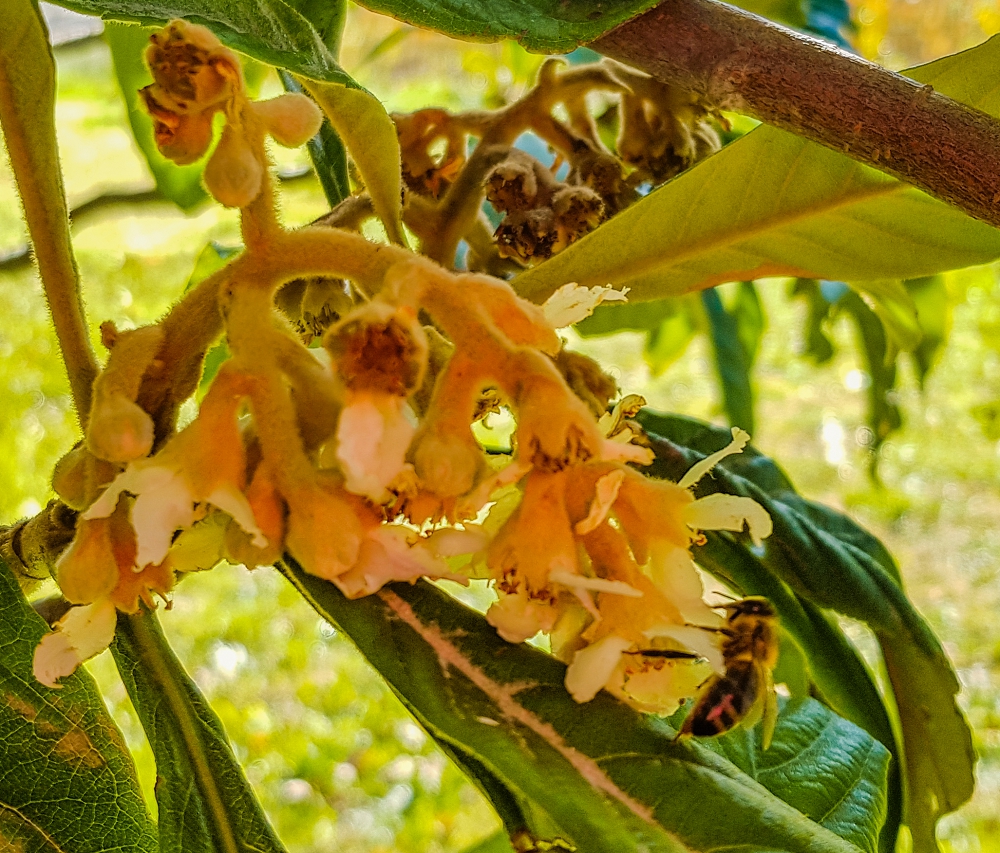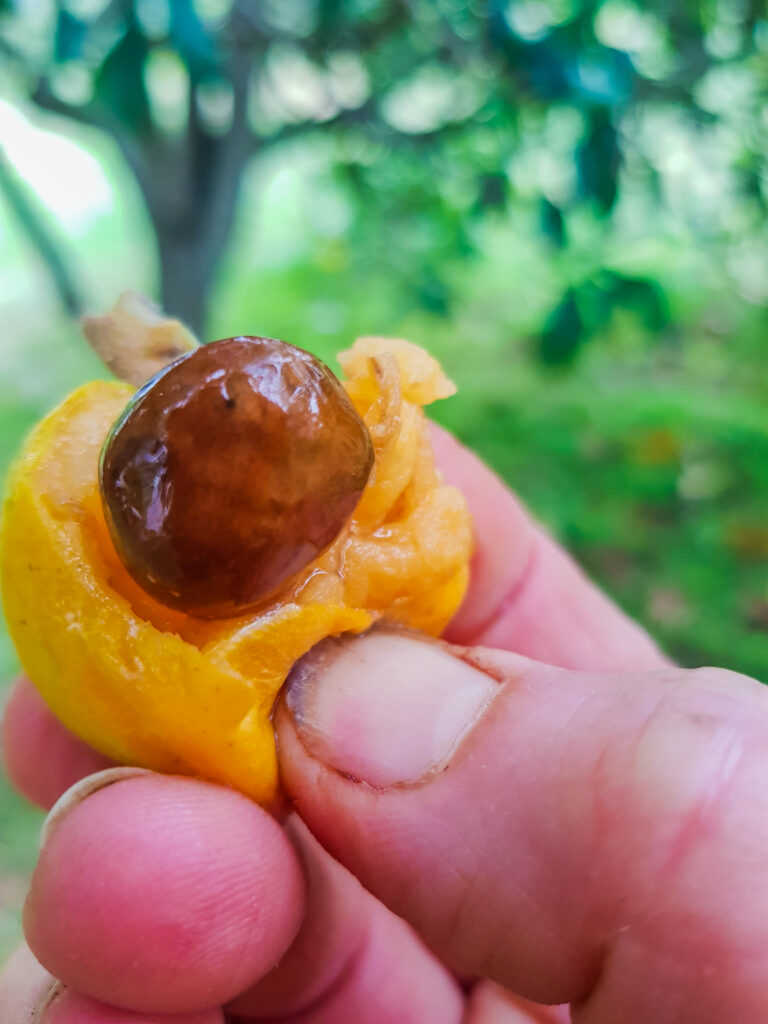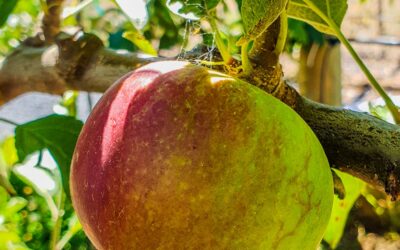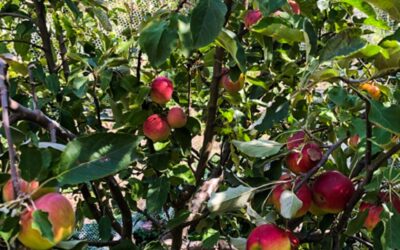Estimated reading time: 9 minutes
If you’re lucky enough to have a loquat tree in your backyard like us, then you know these delicious little fruits are a true treat. Ours is a beautiful big, shady tree that adds a lot to our garden.
Not only does the fruit taste great, but they also have a ton of health benefits.
Plus, they’re super easy to grow, so even if you’re not a green thumb, you can still enjoy the fruits of your labour (literally).
Early-season fruits like loquats can beat fruit fly
One of the best things about loquats is that they ripen very early in the season (late spring at our place). This means you can enjoy them before many other fruits are even ripe.
Early ripening also helps to beat fruit flies. The loquat harvest will usually be finished before fruit fly makes an appearance for the season.
Having said that, loquats can also be one of the early targets of fruit fly! Our advice is to put a fruit fly trap in your loquat tree – it can be your early detection system!
Loquats are not too picky when it comes to soil conditions, so they’re a great option for most gardens.

Are loquats native to Australia?
The loquat is native to China, but it’s common in gardens all around the world.
A loquat tree can grow to 3-6 metres in height – so quite large. It has a rounded canopy and glossy, evergreen leaves, and it produces small, oval-shaped fruits that are yellow or orange when ripe.
Our loquat tree is over 30 years old and has been planted quite close to the house. We never prune it because we appreciate it the shade and beauty it provides.
The fact that it bears fruit almost every year is a welcome bonus.
Choosing the right site for your loquat tree
When choosing a site for your loquat tree in your garden, there are a few key things to consider.
First, loquat trees prefer full sun, so make sure to choose a spot that gets plenty of sunlight throughout the day. They also prefer well-draining soil, so avoid areas that tend to stay wet or soggy.
Loquat trees are also quite cold-sensitive, so make sure to choose a spot that’s protected from frost. In colder climates, it’s best to plant your loquat tree in a sheltered spot near the north side of your house, where it will be protected from the wind and cold.
Finally, give your tree enough space to spread out and mature. A mature loquat tree can have a canopy that spreads up to 6 metres in diameter, so give it plenty of room to grow. If you’ve got the space for a loquat, they’re a beautiful shade tree as well as being very productive.
Loquat flowers are fragrant and beautiful. They’re also a fantastic source of food for bees and other pollinators at a time when there’s not much other food around.

Health benefits of loquats
Loquats have lots of health benefits. They’re packed with vitamins and nutrients, and they’ve been used for centuries in traditional medicine for their therapeutic properties.
For example, they’re super high in vitamin C. Just one cup of loquats contains more than 60% of your daily recommended intake of vitamin C. This makes them a great choice for boosting your immune system. Vitamin C is also an antioxidant, which means it can help protect your cells from damage caused by free radicals.
Loquats are also a good source of dietary fibre, which is great for healthy digestion, lowering cholesterol, and controlling your blood sugar. Plus, the fibre in loquats is mainly insoluble, which means it can help keep you feeling full and satisfied.
Finally, loquats are high in potassium, which is key for maintaining healthy blood pressure levels. It can also help to keep your muscles and nerves functioning well, and it’s even been shown to have a protective effect against stroke.

Loquat recipes
Eating them fresh is always the easiest. But we know from experience that loquat trees can be very prolific.
An important measure of the success of most fruit trees is whether you use the fruit. Eating it fresh is best, but it’s also great to have a range of recipes up your sleeve.
If you can’t eat all your loquats while they’re at their peak, you’ll need some good recipes.
Loquats have one (or more) large seeds inside. On some varieties, there’s not a lot of flesh, so cooking them can be a bit fiddly. So let’s start with the simplest recipe that doesn’t involve seeding or peeling.
Loquat jelly
This sweet and tangy spread is perfect on toast, scones, or even mixed into yoghurt. To make loquat jelly, you’ll need
- 3 cups of loquats
- 2 cups of water
- 3 cups of sugar (approx.)
- 1 lemon, juiced
Start by placing the loquats and water in a medium saucepan and bringing them to a boil. Reduce the heat to medium-low and let the loquats cook for about 20 minutes, or until they’re very soft.
Strain the fruit through some muslin for a few hours or overnight. Don’t squeeze the muslin or your jelly will be cloudy.
Measure the liquid back into your saucepan, and add the same number of cups of sugar. Add the lemon juice and bring the mixture back to a boil. Boil until it reaches the gel stage.
To test if your jelly is ready, drop a small amount onto a chilled plate and put it in the freezer to cool quickly. If it wrinkles when you push it with your finger, then it’s ready. If not, continue boiling and testing every few minutes until it reaches the right consistency.
Once your jelly is ready, transfer it to sterilised jars.
Loquat and strawberry jam
- 3 cups of loquats, peeled and seeded
- 1 cup of strawberries, hulled and sliced
- 1/2 cup of water (or just enough to make sure the fruit doesn’t stick to the saucepan before the juice is released from the cooking process)
- 3 cups of sugar
- 1 lemon, juiced
Start by placing the loquats, strawberries and water in a medium saucepan and bringing them to a boil. Reduce the heat to medium-low and let them cook for about 20 minutes, or until they’re very soft.
Next, add the sugar and lemon juice and bring the mixture back to a boil. Let it boil for about 10 minutes, or until it reaches the setting stage (test in the same way as for loquat jelly).
Once your jam is ready, transfer it to sterilised jars.
This jam has a delicious combination of sweet and tangy flavours from the loquats and strawberries. Plus, it’s a great way to use up both of these seasonal fruits at the same time.
Loquat and walnut cake
- 2 cups plain flour (also works well with gluten-free flour)
- 1 teaspoon of baking powder
- 1/2 teaspoon of salt
- 1 cup of butter, softened
- 1 cup of sugar
- 4 large eggs
- 1 teaspoon of vanilla extract
- 2 cups of peeled and seeded loquats, chopped
- 1/2 cup of chopped walnuts
Sift the flour, baking powder and salt. In a large bowl, beat the butter and sugar together until light and fluffy. Add the eggs one at a time, beating well after each addition. Stir in the vanilla extract.
Gradually add the flour mixture to the butter mixture, stirring until just combined. Gently fold in the loquats and walnuts. Pour the batter into the prepared baking pan and smooth the top.
Bake for about 35-40 minutes at 280C. Let the cake cool in the pan for 10 minutes, then transfer it to a wire rack to cool completely. Dust the top with icing sugar or ice with lemon icing.
Loquat compote
This versatile compote is great as a topping for pancakes, waffles, or yoghurt. To make it, combine 3 cups of peeled and seeded loquats, 1/2 cup of water, 1/2 cup of sugar, and the juice of 1 lemon in a medium saucepan. Bring the mixture to a boil, then reduce the heat to medium-low and let it simmer for about 20 minutes, or until the loquats are very soft. Let the compote cool, then transfer it to a container and refrigerate until ready to use.
Loquat and honey vinaigrette
This sweet and tangy vinaigrette is great on salads, roasted vegetables, or even grilled chicken or fish. To make it, whisk together 1/4 cup of loquat jelly, 2 tablespoons of honey, 1 tablespoon of apple cider vinegar, and 1/4 cup of olive oil in a small bowl. Season to taste with salt and pepper, and use immediately, or store in the fridge for up to a week.
Related Articles
How to prune your apple tree
Pruning apple trees takes a little more specialist knowledge than other fruit types, but your trees will reward you with ample crops.
Warming winter cakes with home-grown fruit
Bake delicious warming winter cakes from the fruit you’ve grown on the fruit trees in your own garden for extra satisfaction.
How to grow your own multigraft or fruit salad tree
Multigraft trees are a no-brainer for many gardens, as they reduce risk and provide a bigger variety of fruit, without taking up more space.








So loquat tree can’t be grown in pots ?
Hi Nadia, You can definitely grow a loquat tree in a pot, although they can quickly outgrow even large containers. You can obtain dwarfing varieties to might be worth hunting around for one of them. Meg – GGF team.
Are there dwarf varieties available?
Hi John, yes, you can get dwarf loquats – I believe they can be grafted onto a quince rootstock. In the past, Daleys Nursery have sold them. Thanks, Meg – GGF team.
Hello I have a 16 year old loquat tree, that has in the last 2 years had lots of flowers, but the fruit does not grow, the flowers just dry up. Any suggestions please. Suz
Hi Suz, bit hard to say. Has it fruited in the past?